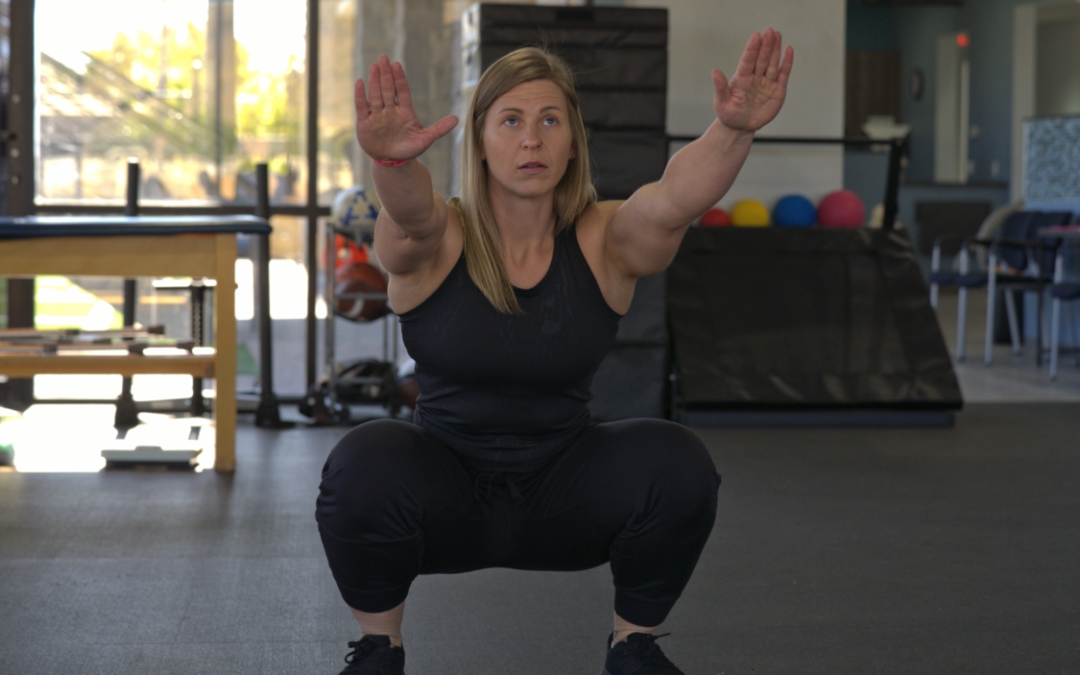By: Caralyn Debash, PT, DPT
A squat is a vital, natural and functional component of your being, and is required for many daily tasks. We squat to get on and off of the toilet, out of our dining room chair, and when getting up and out of bed in the morning. Squats not only build strength, but they can help athletes prevent the risk of future injury. This exercise is often added to a strength training routine, so learning proper form is vital.
Proper Squat Form:
A squat looks different for many people. Some variables are dependent on leg length or position of acetabulum–the socket of your hipbone–within the pelvis, but in general a basic squat set up is fairly consistent. A basic air squat will start with your feet shoulder width stance apart with toes turned slightly outward, followed by hips and knees breaking evenly as you descend towards the ground. Knees track over the toes all while maintaining a neutral spine during the entirety of the movement. In order to perform a proper squat, there are a variety of mobility requirements needed to help you be successful.
No matter where your optimal squat is–parallel or below parallel–you will need adequate ankle mobility as well as full hip and knee flexion. What happens if one or more of those mobility requirements are limited or certain strength imbalances are present, and what types of faults do we typically see?
What are common form faults in squatting and what do they look like? How can these be fixed?
Good Morning Squat:
A good-morning squat is when an individual ascends out of the bottom of a squat with hips shooting up and back first, leaning their torso forward. This typically happens when a person is catering to their strengths, meaning their quads may be relatively weaker in comparison to their posterior chain- including the glutes, hamstrings, and calf muscles. If glutes are more dominant, this squat tends to look more like a deadlift on the ascent to stand. Quad dominant exercises, such as heel-elevated squats or Spanish squats would be good options to train and strengthen the anterior chain.
Good-morning squats are sometimes seen not from a strength imbalance or a mobility deficit, but more so from outdated and misinterpreted literature to avoid letting the knees go over the toes. When you avoid letting your knees go over your toes, it can increase your likelihood to perform a good-morning squat- which can cause strain on your hips and back musculature. The simple cue of “sit down, not back” is helpful in loading all of the joints properly in a squat rather than not letting the knees go over the toes at all.
Weight-Shifting-Forward Squat:
When initiating a squat, the hips break first and are followed closely by knees breaking to allow for a “sit down” action. Contrary to a good morning squat, an individual may squat leading with the knees bending forward, with little to no hip bend, contributing to lack of posterior chain engagement. The heels in this squat fault will rise and the weight will shift forward. This can also be corrected with verbal cueing of “sit back” or tactile cues to aim when descending through the movement.
Valgus Knee Position Squat:
When you see an individual with their knees caving in during the squat, there is likely to be some muscular weakness, usually within the hip abductors or adductors with lack of stability during the squat. A simple verbal cue or banded feedback around the knees may help with hip and knee alignment if this is the case.
However, in other cases, when an individual is under heavier loads, a brief moment of knees caving in may occur, but very quickly the knees return to a stacked and neutral position over the toes. This is a quick bout of adductor musculature recruitment creating additional hip extension torque to arise out of the bottom of a squat and what they call an “adductor whip.” This is common in deeper ranges of the squat and under heavier loads seen in even the most elite lifters.
Collapse of Neutral Spine:
For the entirety of the ascent and descent of the squat, the goal is to maintain a neutral spine and avoid collapsing into a flexed and or rounded back. This may be from muscle flexibility imbalances, such as tightness through hamstrings contributing to pelvic position at the bottom. A loss of neutral spine where depth and/or weight shifting may also be faltering is what one may call an “immature squat.” This is where simple yet effective drills to train correct mechanics can be implemented. Squat therapy is a corrective technique where you face the wall in your preferred squat stance with arms extended in front of you, and you squat down keeping arms extended to promote an upright chest and neutral spine. You gradually move closer to the wall as torso ankle and depth allows.
Squat therapy–along with other various corrective techniques such as tempo or isometric holds–are all great ways to train this functional movement that is essential to daily life. Just like any movement, specific mobility and strength requirements will promote the most success with squatting optimally.
Wider Stance Squat:
A wider stance is not necessarily a fault, but it does bring attention to a few joints and mobility aspects we may want to assess further. Someone with longer limbs will have further to go and may need a wider stance set up to make room for pelvis to sit at bottom of squat all while maintaining a neutral spine. Similarly, an individual with limited ankle mobility may also prefer a wider stance where their tibias do not have to go as far over the toes. This allowing them to avoid rocking on to their toes–losing contact with heels on the ground in a narrower stance.
Spooner physical therapists are movement experts who can help you achieve proper squat form. Schedule an appointment today!

